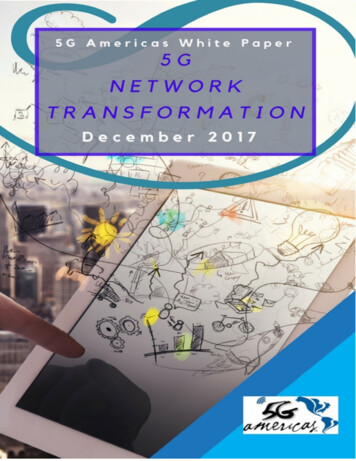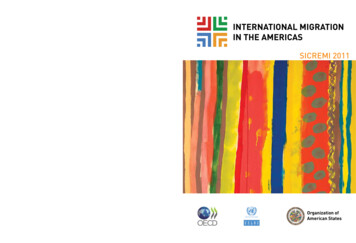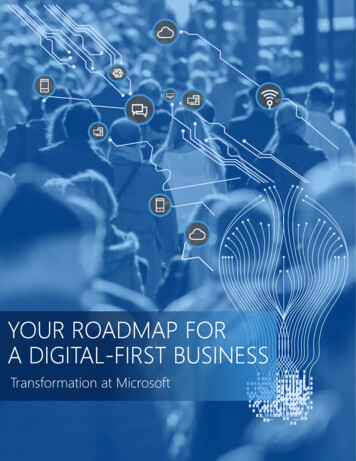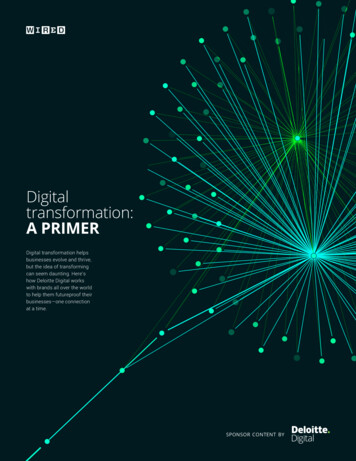
Transcription
5G Network Transformation: Copyright 2017 5G AmericasTABLE OF CONTENTSExecutive Summary . 31. Introduction . 32. Use Cases . 52.1 Use Case Categories . 52.1.1 Enhanced Mobile Broadband . 62.1.2 Connected Vehicles . 62.1.3 Enhanced Multi-Media . 72.1.4 Massive Internet of Things . 72.1.5 Ultra Reliable Low Latency Applications . 82.1.6 Fixed Wireless Access . 92.2 Use Case Requirements . 93. Standardization & Industry Landscape . 123.1 Industry Standards Organizations . 123.1.1 3GPP . 123.1.2 5GTF – 5G Technical Forum . 143.1.3 ITU - International Telecommunications Union . 153.1.4 IETF . 153.1.5 Additional SDOs & Forums . 154. 5G Core . 164.1 Core Network Functions . 174.2 5G Core Interactions . 194.3 5G Core and EPC Interworking Variants. 214.4 Network Slicing . 224.4.1 High-level Architecture . 235. RAN . 245.1 Layer 1 . 251
5G Network Transformation: Copyright 2017 5G Americas5.2 Layer 2 . 256. Wireless Self-Backhaul . 307. Conclusion . 30Glossary . 32Acknowledgements . 382
5G Network Transformation: Copyright 2017 5G AmericasEXECUTIVE SUMMARYThe evolution of the 5G New Radio and Next Generation Core is a major driver for innovation. Byintroducing three new improved characteristics - low latency, distribution, and through-put - new businessopportunities are able to be addressed. 3GPP is the main standards body where 5G is being addressedwith Release 15 with expected completion in May of 2018. As standards evolve, 5G technology willtransform networks and operations in new ways. Network Function Virtualization Infrastructure (NFVI) isone area in which technology and operational models will change.Automation and orchestration will transform how networks of the future are built and operated. Networktransformation will happen through large scale adoption of Network Functions Virtualization (NFV),orchestration of network services, and automated network management. Artificial intelligence, machinelearning, and adoption of new 5G technologies will transform network operation models and businesseconomics leading to the creation of widely distributed, highly dense, high bandwidth mobile networks. Usecases like immersive Augmented Reality / Virtual Reality (AR/VR) and Autonomous Driving can changehow humans consume and interact with technology. These new use cases and other emerging use caseswill alter consumption patterns and lead to the creation of new services and new revenue opportunities forcarriers.In this paper, some of the emerging use cases, standardization, architecture and technology advancementswith the fifth generation of mobile networks are explained.1. INTRODUCTIONIf a common sentiment from 5G can be distilled, it’s that 5G will be an innovation engine, bringing disruptivechange across industries and society. Worldwide mobile subscriptions now total around 7.4 billion; by 2021,the number will grow to 9 billion. IoT devices with cellular subscriptions will leap from 400 million today to1.5 billion by 2021. 1 5G will accelerate this transformation and create new use cases, new revenue streams,and new business models for industries and consumers. Industries will benefit from 5G by connectingphysical world devices to the internet in order to create innovative products or services, provide a bettercustomer experience, increase efficiency, and/or improve safety. With 5G, industries will have connectivitythat is customized for their requirements and the agility to move quickly to meet customer needs.5G, being the next generation mobile networking standard, brings several new components. Two of themost important features are low latency ( 10ms) and high through-put (Multi-Gbps). Using these newenhancements, operators will be able to address the market by addressing new use cases. 5G enhancesthe use cases that LTE is able to minimally address today, and brings new revenue streams to operatorsby leveraging new solutions that LTE was not able to serve. 3GPP Release 15 defines 5G and is expectedto be completed by mid- 2018. In preparation for the launch of 5G over the years to come, operators havemany tasks to accomplish for 5G technology transformation.When reviewing the life cycle of the wireless telecommunications industry, technology leaps have occurredroughly every 5-10 years for the past three decades. Since LTE’s first deployment in 2010, LTE has beenthe most rapidly deployed wireless technology. There have been many advancements in LTE (for example.LTE-Advanced) and yet the industry is striving for another leap to 5G by 2020. Because LTE is so widelyadopted and successfully deployed, many features targeted for 5G will actually debut on LTE networks.1Ericsson Mobility report. Nov 20163
5G Network Transformation: Copyright 2017 5G AmericasThe network architecture for 4G is connection-oriented and based on centralized mobility anchor points.With the exploding demand indicated in the Use Case Requirements section, it is clear that the LTEarchitecture will be unable to satisfy the scalability, latency, or overall experience required in futurenetworks. Fortunately, there is momentum and innovation in the industry toward meeting the requirementsof 5G use cases. The new 5G architecture brings improved radio units with a much faster air interface whencompared to LTE and a new Service Based Architecture for the Core.Figure 1. 5G Converged Architecture.5G promises ubiquitous wireless coverage. Radios leveraging licensed and/or unlicensed spectrum, smallcells, macro LTE eNodeBs, fiber, microwave, leased Ethernet, or satellite backhaul will be considered whenoffering services. Given the service performance requirements, it is possible that not all services will beavailable in all areas of ubiquitous coverage. It will be essential to maintain continuity, as devices changelocations and move between different types of networks.Figure 1 indicates how functions will be involved in providing network services. Each service will havecertain characteristics, such as QoS or Mobility. These services can be assigned to dedicated and/or sharednetwork slices. Each network slice will be realized by creating one or more virtual networks, each of themwith certain performance characteristics. User-subscribed services will be mapped to the slices. With thepotentially infinite number of network slices that will be needed, a strong Network Function VirtualizationInfrastructure (NFVI) will be necessary. Orchestration, Analytics, and automation will play a key role intransforming a network to support and run the 5G network.The revolution towards the 5G innovation engine is well underway. In following sections, the technologyand transformation required to leverage 5G is explained.4
5G Network Transformation: Copyright 2017 5G Americas2. USE CASESWith the prospect of universal availability of instantaneous communications, a high level of guaranteedQoS, and lower cost points, 5G is looking to pave the way for new use cases and new businessopportunities. 5G architecture is expected to accommodate a wide range of use cases with requirementsproviding a wide range of capabilities in terms of latency, coverage, bandwidth and robustness.5G is also expected to meet another important challenge; it will provide an end-to-end network and cloudinfrastructure using network slicing making it possible to meet the various requirements of a diverse set ofuse cases.Numerous use cases with a wide variety of applications are on the rise with a highly varied range ofperformance attributes such as mobility, data speed, latency and reliability. The supporting user data ratescould range from a few kbps for some IoT devices where power consumption will be extremely low, tomultiple Gigabits per second used by Augmented Reality and Virtual Reality (AR/VR) or high quality multimedia applications. Mobility supported by the use cases could range from fixed wireless high capacity, highdata rate applications to high velocity trains or aircraft at speeds of 500 mph.Ultra-low latency, in the order of 0.5 ms, is needed to enable real-time applications like industrial automationand is very different from smart home applications that may be more delay tolerant. Reliability is critical forremote surgery and health care monitoring, but may be less so for some remote sensors and meters insmart cities. A wide variety of use cases are considered and chronicled as part of forming the basicrequirements for 5G in multiple studies.1.2.3.4.5.5G Use Case and Services, White Paper by 5G Americas, 29 November 2017 2NGMN 5G White Paper, NGMN, 17 February 2015 3The 5G Business Potential, Ericsson, February 2017 45G Use Cases and Requirements White Paper by Nokia, April 27 55G Use Cases, presentation by Ericsson, 2015 6In the following sections, the emerging key use cases and categories that will be supported by 5G aresummarized.2.1 USE CASE CATEGORIESThe following is a general and well accepted grouping of use cases that will be supported by 5G:1.2.3.4.5.6.Enhanced Mobile BroadbandConnected VehiclesEnhanced Multi-MediaThe Massive Internet of ThingsUltra-Reliable Low Latency ApplicationsFixed Wireless Access (Early 5G 1190/8811/5G Services and Use nt/downloads/Technical/2015/NGMN 5G White Paper V1 local/news/2015/7/5g-use-cases.pdf35
5G Network Transformation: Copyright 2017 5G Americas2.1.1 ENHANCED MOBILE BROADBANDEnhanced Mobile Broadband (eMBB) is characterized by broadband data access in specific locations suchas crowded spaces or office areas, across a wide coverage area, or in a high-speed public transport system.It provides maximum user experience with connectivity both indoors and outdoors while delivering highQoS broadband even in challenging network conditions. Multi-user interaction, Augmented Reality andContext Recognition are essential features for this category of use cases. Several sub-use cases in thiscategory are: Hot Spots – Broadband Access in Dense Areaso This use case relates to providing high enhanced broadband access in densely populatedareas such as high-rise building complexes, urban city centers, crowded areas, andetceteraGeneral Broadband Everywhereo This use case relates to providing a consistent user experience, guaranteeing improveduser speeds of estimated 50 Mbps everywhere towards a mobile and a connected society.The user data has to be delivered consistently across the coverage areaPublic Transporto Public transport is about providing broadband access in public transport systems such ashigh-speed trains. The use case consists of providing robust communication link and highquality mobile internet for information, entertainment, interaction or workSmart Officeso This use case in characterized by heavy data use in an Indoor Environment. Hundreds ofusers require ultra-high bandwidth to serve intense bandwidth applications. Low latencyserved by a distributed user plane could also be leveraged in this scenarioSpecific Eventso This use case requires providing very high connection density in scenarios such as inStadiums, concerts and Large Gatherings where several hundred thousand users areserved at high data rates with low latency. This would bring the ability to serve content suchas instant replays or 360 degrees viewing to all users2.1.2 CONNECTED VEHICLESThe category of use cases for mobile communications related to Connected Vehicles is going to be animportant driver for 5G. This category of use cases entails supporting advanced safety applicationsmitigating road accidents, improving traffic efficiency, smoother traffic for emergency vehicles. Theseapplications require a concerted framework with features supporting ultra-low latency for warning signals,higher data rate to share video information between vehicles and infrastructure, high mobility, high reliabilityand scalability features. The following are the key communication framework and use cases that need tobe established for Vehicle to Everything Communications (V2X): The V2X communication encompasses data exchange between vehicles and otherinfrastructure to improve road safety and increase traffic. V2X communications as definedin 3GPP consists of four types: V2V, V2I, V2N and V2PV2V and V2P communications are essentially between vehicles or between vehicles andvulnerable road users (for example, pedestrian, cyclist) to provide information aboutlocation, velocity and direction to avoid accidentsV2I transmission is between a vehicle and a road side unit (RSU). V2N transmission isbetween a vehicle and a V2X application server. An RSU is used to extend the range of a6
5G Network Transformation: Copyright 2017 5G AmericasV2X message received from a vehicle by acting as a forwarding node. V2I includescommunications between vehicles and traffic control devices in the road vicinity2.1.3 ENHANCED MULTI-MEDIAThis category of use cases is targeted towards providing high quality media everywhere to meet the growingdemands of consumer media consumption. The targeted users are regular consumers of media, pay TVoperators, broadcasters, new content owners, aggregators, and OTT providers. These use cases aim toprovide high quality video anywhere and meet all TV consumer demands. Recent developments of 4K, 8K3D Videos, expanded use of HD TV, streaming audio and video services, and interactive video on the goover growing number of devices, are key driving factors for this family of use cases. The enhanced datacapacity, the high data rates and the enhanced broadcast/multicast features will essentially serve theseuse cases aiming to provide TV for in-home screens and realize the media vision for mobile TV. Some ofthe Enhanced Multi-Media use cases are as follows:Broadcast ServicesThese services distribute real time and non-real-time content, are typically heavy on the downlink, andprovide a feedback channel for interactive services in wide distributed areas. Sub-use cases consist of: Delivering news and information in audio and video everywhere to customers in all geographicareasDelivering local services within 1 to 20 kms that includes scenarios such stadium events,advertisements, fairs, conventions and emergency servicesDelivering services in a larger distribution within 1 to 100 kms that includes scenarios such ascommunicating traffic jams, disaster emergency warnings, and jetceteraDelivering services at a national level, complimentary to broadcast radio or television, providingbenefits for the automotive industryOn Demand and Live TVThis use case is based on scaled-up content delivery on live TV or on demand providing high quality videousing enhanced data capacity and data rates.Mobile TVEntertainment and video streaming on smart phones, tablets and other devices in high mobilityenvironments such as trains, cars and airplanes defines this use case.2.1.4 MASSIVE INTERNET OF THINGSThe category of use cases in Massive Internet of Things essentially addresses the emerging Low PowerWide Area (LPWA) needs for low cost devices, extended coverage and long battery life. The use cases inthe category of massive Internet of Things are expected to make up a large part of the new types of servicesand use cases that 5G systems will address. This category consists of growing use cases with a massivenumber of devices such as sensors, actuator, cameras, and etcetera.This family of use cases are expected to be pervasive in urban, sub-urban and rural areas providingmetering, city or building lights management, environment monitoring (pollution, temperature, noise,etcetera), and traffic control, among many other applications. The combined number of these services isexpected to require supporting a very high density of devices with different characteristics in a common7
5G Network Transformation: Copyright 2017 5G Americascommunication framework. Massive IoT covers a wide spectrum of use cases across many industries andsocieties, as shown in Figure 2.AgricultureClimate/agriculture monitoringLivestock trackingUtilitiesSmart meteringSmart grid managementTransport and logisticsFleet managementGoods trackingSmart citiesParking sensorsSmart bicyclesWaste managementSmart lightingMassiveIoTEnvironmentFlood monitoring/alertsEnvironmental monitoring(water, air, noise, etc.)Smart buildingsSmoke detectorsAlarm systemsHome automationIndustrialProcess monitoring andcontrolMaintenance monitoringConsumersWearablesKids/senior trackerMedical monitoringFigure 2: Massive IoT Verticals Enabled by 5G Technologies 72.1.5 ULTRA RELIABLE LOW LATENCY APPLICATIONSThese set of use cases are the Critical IoT applications that will have very high demands on reliability,availability and extremely low latency where the volumes are typically much smaller, but the business valueis significantly higher. As listed in table 1, the latency range for these type of use cases ranges from .5milliseconds to 5 milliseconds. These use cases also fall into the category of mission-critical machine typecommunication use. The mission-critical MTC is envisioned to enable real-time control and automation ofdynamic processes in various fields, such as industrial process automation and manufacturing, energydistribution, intelligent transport systems. These applications and use cases requires communication withvery high reliability and availability, as well as very low end-to-end latency going down to millisecond level.Process Automation 78These use cases are centered on information integration enabling process automationuseful in oil and gas, chemicals, energy and water industries. The application here coverspumps, compressors, mixers, monitors of temperature, pressure, flow and etcetera. s/white-papers/wp iot.pdfARC Advisory Group8
5G Network Transformation: Copyright 2017 5G AmericasAutomated Factories These use cases involve communication transfers enabling time-critical factory automationthat are required in many industries across a wide spectrum that includes metals,semiconductor, pharmaceuticals, electrical assembly, food and beverage etc. Applicationsfor these use cases fall into functions related to material handling, filing, labeling,palletizing, packaging, welding, stamping, cutting, metal forming, soldering, sorting,printing presses, web drawing, picking and placing, and etcetera.Tactile Interaction These use cases involve interaction between humans and systems where humanswirelessly control real and virtual objects and the interactions require a tactile control signal,and audio or visual feedback. Robotic controls and interactions include several scenarioswhere most applications are found in manufacturing, remote medical care and autonomouscars. These tactile interactions require real-time reactions in the order of sub-milliseconds.Emergency, Disasters and Public Safety These use cases require robust and reliable communications in case of natural disasterssuch as earthquakes, tsunamis, floods, hurricanes, etcetera. These use cases may requireaccurate location identification and quick communication exchanges between users andsystems. Energy efficiency in user battery consumption and network communications arecritical for these use cases. Public safety organizations require enhanced and securedcommunications. Public safety use cases include requirements like real time video and theability to send high quality pictures.Urgent Health Care/ Remote Surgery These use cases are envisioned around applications that will conduct remote treatment.Applications include monitoring and surveillance of patients remotely and communicationswith devices such as ECG, pulse, blood glucose, blood pressure, and temperaturemonitors. These critical remote patient treatments and heath care responses, based onmonitored data, can be immediate, automatic, or semi-automatic. Remote surgeryapplications in a mobile scenario in ambulances, in disaster situations, and in remote areasrequire providing precise control and feedback communication mechanisms. Latency,reliability and security of these messages are critical for remote medical healthprofessionals.2.1.6 FIXED WIRELESS ACCESSFixed Wireless Access could be one of the first use cases to be addressed in early 5G deployments. Thecombination of fiber and 5G will be part of the same network in the future. This use case is an importantapplication of the enhanced broadband features of 5G. Fixed networks with 5G are expected to complementfiber to provide very high-speed data rates. Fixed wireless use cases using 5G are geared towards massmarket distribution of on-demand high bandwidth content.2.2 USE CASE REQUIREMENTSThe specific requirements for different use cases can be significant depending on the service beingdelivered. Listed in Table 1 are some early estimations on 5G use case requirements.9
5G Network Transformation: Copyright 2017 5G AmericasTable 1. Use Case Requirements.Use CaseUser Data RateLatencyMobilityHotspots: BroadbandAccess in DenseAreasDL: 300 Mbps –500Mbps10 ms0 – 120 km/h10 ms0 – 120 km/h10 msPedestrian10 msUp to 500 kmph10 msPedestrian1 ms0 – 160 km/h5 ms0 – 160 km/h1 ms0 – 160 km/h10 ms0 – 160 km/h10-50 ms0 – 8 km/h10-50 ms0 – 80 km/h10-50 ms250 – 500 km/h50 ms - hours0 – 500 km/hUL: 50 Mbps – 100MbpsBroadbandEverywhereDL: 25– 50 MbpsUL: 10 – 25 MbpsHomes and OfficesDL: 1 Gbps – 5 GbpsUL: 100 - 500 MbpsPublic Transport,MBB in Cars, HighSpeed TrainsDL: 25 – 50 MbpsBroadband Access inEvents & LargeGatheringsDL: 10 - 25 MbpsConnected Vehicles:V2VDL: 1 - 5 MbpsUL: 10 – 25 MbpsUL: 25 - 50 MbpsUL: 1 - 5 MbpsConnected Vehicles:V2IDL: 1 - 5 MbpsUL: 1 - 5 MbpsConnected Vehicles:V2PDL: 1 - 5 MbpsUL: 100 kbps - 1 MbpsMoving HotspotsDL: 10 - 50 MbpsUL: 5 - 25 MbpsEnhanced MultiMedia: Live TVDL: 50 - 200 MbpsUL: 500 kbpsEnhanced MultiMedia: On DemandDL: 50 - 200 MbpsUL: 500 kbpsEnhanced MultiMedia: Mobile TVDL: 10 - 50 MbpsUL: 500 kbpsMassive IoT: SensorNetworks (ConnectedDL: 1 – 100 kbps10
5G Network Transformation: Copyright 2017 5G AmericasRoads, Railways,Buildings, SmartCities, Parking,Lighting, EnvironmentMonitoring)Massive IoT: SmartGrid/UtilitiesUL: 1 – 100 kbpsDL: 1– 100 kbps50 ms - hoursPedestrian1 - 5 ms0 – 120 km/h1 - 5 msPedestrian0.5 – 1 msPedestrian0.5 – 1 msPedestrian0.5 – 1 msPedestrian1 - 5 ms0 – 120 km/h1 - 5 ms0 – 120 km/h10 msPedestrianUL: 1 – 100 kbpsMassive IoT:WearablesDL: 100 kbps - 5 MbpsUL: 100 kbps – 5 MbpsMassive IoT:AgricultureDL: 1 – 100 kbpsUL: 1 – 100 kbpsIndustry ProcessAutomationDL: 100 kbps - 10 MbpsUL: 100 kbps – 10MbpsAutomated FactoriesDL: 100 kbps – 10MbpsUL: 100 kbps – 10MbpsTactile InteractionDL: 100 kbps - 10 MbpsUL: 100 kbps – 10MbpsEmergency Services,Public SafetyDL: 100 kbps – 10MbpsUL: 100 kbps – 10MbpsUrgent Health CareDL: 100 kbps – 10MbpsUL: 100 kbps – 10MbpsFixed WirelessDL: 100 kbps - 5 MbpsUL: 100 kbps – 1 MbpsThe business potential for 5G will be enabled by the use cases in Table 1. Although some scenarios maybe addressed by LTE today, 5G will enhance them and/or make new use cases possible.11
5G Network Transformation: Copyright 2017 5G Americas3. STANDARDIZATION & INDUSTRY LANDSCAPESeveral industry associations have been researching 5G since 2013. The work has included identifyinguse cases for 5G, requirements for 5G, studying how to measure performance and researching technicalconcepts for 5G. 5G Americas published an excellent White Paper highlighting these pre-standardsresearch efforts 9 that highlighted the dozens of 5G research projects worked across the globe. This early5G research is allowing 5G to be rapidly standardized in organizations like 3GPP, ITU, ETSI, IETF andmore. Some of the key Industry Standards Organizations (SDOs) involved in 5G are highlighted in thefollowing section. It’s important to note that 5G standardization is primarily driven through 3GPP. Manysupporting technologies are needed such as Orchestration, Analytics, NFVI and more. These supportingtechnologies are driven by other organizations such as OPNFV, OpenStack, OpenDaylight and others.3.1 INDUSTRY STANDARDS ORGANIZATIONS5G standards are being reviewed and standardized in multiple SDOs and forums. This section will describea few of the ongoing activities in some of those SDOs.3.1.1 3GPP3GPP is the primary driver for developing 5G standards; however, other organizations will developstandards that could supplement or be used by 3GPP (for example, ITU, IETF, ETSI, ATIS). 3GPP begantheir efforts on 5G with a RAN 5G workshop 10 in September 2015. The workshop preceded RAN Plenary#69 which approved a study item on channel modeling above 6 GHz. Since then, 3GPP has progressedfrom 5G study items, to now developing normative 5G implementable standards.3GPP then began to study use cases for 5G and from the use cases developed requirements. This workwas performed in the 3GPP Services work group (SA1). These requirements were then used to help guidein the selection of technical concepts by other work groups. One of their key documents is: ‘Service andMarkets Technology Enablers (SMARTER) for next generation telecommunications’ with 4 approvedTechnical Reports (TR 22.861, 22.862, 22.863, 22.864) and the SA1 Service Requirements for the 5Gsystem; Stage 1 (TS 22.261). Following is a diagram pictorially showing the four key groups for 5G servicesand /1680/2014 4GA Summary of Global 5G Initiatives 17 18 RAN 5G/1012
ionsuicatmIndustrialControlDrones &RoboticsComConnectivity &RoutingicalMigration &InterworkingCritNetwork Slicing &ReconfigurationNetwork Operations5G Network Transformation: Copyright 2017 5G AmericasMissionCritical DataeHealth/eFarm/eCity, etc.Massive MTCWearablesEnhanced Mobile BroadbandInventoryManagementAugmented& Virtual RealityUltra-high-definition& HologramHigh Mobility(Trains, planes, etc.)Figure 3. 3GPP Identified Key Use Cases for 5G Services & Requirements. 11In March 2017, 3GPP approved the work plan for the initial releases of 5G standards. 123GPP RAN #75 (March 2017)
Network Function Virtualization Infrastructure (NFVI) is one area in which technology and operational models will change. Automation and orchestration will transform how networks of the futureare built and operated. Network transformation will happen through large scale adoption of Network Functions Virtualization (NFV),










